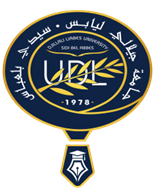Etude expérimentale et théorique des propriétés spectroscopiques de liquides ioniques
| dc.contributor.author | DRAI Mokhtar | |
| dc.contributor.author | Encadreur: HADDAD Boumediene | |
| dc.contributor.author | Co-Encadreur: MIMANNE Goussem | |
| dc.date.accessioned | 2024-07-15T09:59:37Z | |
| dc.date.available | 2024-07-15T09:59:37Z | |
| dc.date.issued | 2021-02-23 | |
| dc.description | Doctorat en Sciences | |
| dc.description.abstract | Résumé (en Français) : Les liquides ioniques, une nouvelle classe de matériaux apparue au vingt et unième siècle, prometteurs dans nombreuses applications. Leurs propriétés configurables et très prometteuses pour une chimie plus durable. Ces nouveaux matériaux ont suscité un intérêt spectaculaire auprès de la communauté scientifique internationale, néanmoins, très peu de laboratoires algériens travaillent sur ces nouveaux matériaux. Ce doctorat a été en relation directe avec un projet de Recherche Formation Universitaire nommé PRFU. L’objectif de cette thèse est de parvenir à une compréhension approfondie des propriétés thermiques, structurales et spectroscopiques vibrationnelles des liquides ioniques à base 1-méthyl-3-alkylimidazolium. Dans une partie purement synthétique, une série de huit liquides ioniques ont été synthétisés avec succès à partir des précurseurs non ioniques ; 1-méthylimidazole [1-mim]. Les structures des ILs synthétisées ont été confirmées par spectroscopie 1H, 13C-19F RMN et IR. Afin d’évaluer les résultats de l’analyse thermique de nos liquides ioniques déjà synthétisés, une étude des propriétés thermiques a été effectuée pour contrôler les différentes comportements thermiques dans chaque liquide ionique. Les résultats montrent que la stabilité thermique de nos liquides ioniques dépend essentiellement de la structure de l’anion. Ainsi, les liquides ioniques couplés avec le Bis(trifluoromethylsulfonyl)imide [NTf2-] sont thermiquement les plus stables et engendrant les plus faibles interactions intermoléculaires induisent les températures de décomposition les plus élevées, avec l’ordre : [NTf2-] > [I-] > [Br-]. L’analyse des propriétés structurales par RMN nous a permis d’identifier les changements structuraux (propylation en position N3 et la méthylation en position C(2)) effectues sur les deux précurseurs non-ionique ; 1-méthylimidazole [1mim] et 1,2-diméthylimidazole [1,2-Dmim]. Les résultats ont été discutés principalement en termes des différents environnements électroniques, les glissements chimiques et les déplacements chimiques à savoir les protons d’imidazolium C2-H, C4/5-H en fonction des bandes déjà appariées dans les mesures FTIR/ATR et Raman, spécialement dans la gamme spectrale 3600-2800 cm-1. Cette dernière méthode a fourni des informations les plus intéressantes sur l'influence de la présence de liaisons hydrogène qui s'établissent entre le couple (cation-anion). Une étude des propriétés spectroscopiques vibrationnelles détaillée des ILs avec leurs précurseurs de départ a permis de mieux comprendre les interactions entre le cation et l’anion associé en utilisant la spectroscopie Raman et IR dans les gammes de nombres d'onde [45 à 3500 cm-1] et [600 à 4000 cm-1], respectivement. Une dernière partie est consacrée à l’étude conformationnelle et spectroscopiques théorique en combinant une approche expérimentale et une approche numérique. Les mots clés : Liquides Ioniques(ILs); 1-méthyl-3-alkylimidazolium; Méthylation; DSC; FTIR/ATR et Raman; Propriétés Thermiques; Spectroscopie Vibrationnelles Abstract (en Anglais) : Ionic liquids, a new class of materials that appeared in the twenty-first century, showing promise in many applications. Their configurable and very promising properties for a more sustainable chemistry. These new materials have aroused spectacular interest from the international scientific community, nevertheless, very few Algerian laboratories are working on these new materials. This doctorate was directly related to a University Training Research project named PRFU. The objective of this thesis is to gain a deep understanding of the thermal, structural and vibrational spectroscopic properties of 1-methyl-3alkylimidazolium based ionic liquids. In a purely synthetic part, a series of eight ionic liquids have been successfully synthesized from the nonionic precursors; 1-methylimidazole [1-mim]. The structures of the synthesized ILs were confirmed by 1H, 13C, 19F-NMR and IR spectroscopy. In order to evaluate the results of the thermal analysis of our already synthesized ionic liquids, a study of thermal properties was carried out to control the different thermal behaviors in each ionic liquid. The results show that the thermal stability of our ionic liquids depends primarily on the structure of the anion. Thus, ionic liquids coupled with Bis (trifluoromethylsulfonyl) imide [NTf2-] are thermally the most stable and generating the weakest intermolecular interactions induce the highest decomposition temperatures, with the order: [NTf2-]> [I-]> [Br-]. Analysis of the structural properties by NMR allowed us to identify the structural changes (propylation in the N3 position and methylation in the C(2) position) carried out on the two nonionic precursors; 1-methylimidazole [1-mim] and 1,2-dimethylimidazole [1,2-Dmim]. The results were discussed mainly in terms of the different electronic environments, chemical shifts and chemical shifts namely the C2-H, C4/5-H imidazolium protons as a function of the bands already paired in the FTIR / ATR and Raman measurements, especially in the spectral range 3600-2800 cm-1. This latter method has provided the most interesting information on the influence of the presence of hydrogen bonds which are established between the couple (cation-anion). A study of the detailed vibrational spectroscopic properties of ILs with their starting precursors has made it possible to better understand the interactions between the cation and the associated anion using Raman and IR spectroscopy in the wavenumber ranges [45 to 3500 cm-1] and [600 to 4000 cm-1], respectively. A final part is devoted to the conformational and theoretical spectroscopic study by combining an experimental approach and a numerical approach. Keywords : Ionic Liquids (ILs); 1-methyl-3-alkylimidazolium; Methylation; DSC; FTIR / ATR and Raman; Thermal Properties; Vibrational Spectroscopy. | |
| dc.identifier.uri | https://dspace.univ-sba.dz/handle/123456789/1548 | |
| dc.title | Etude expérimentale et théorique des propriétés spectroscopiques de liquides ioniques | |
| dc.type | Thesis |
